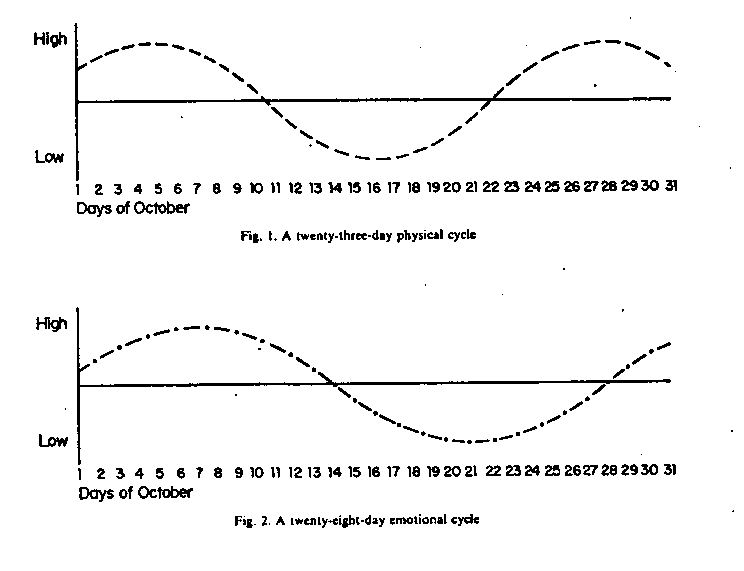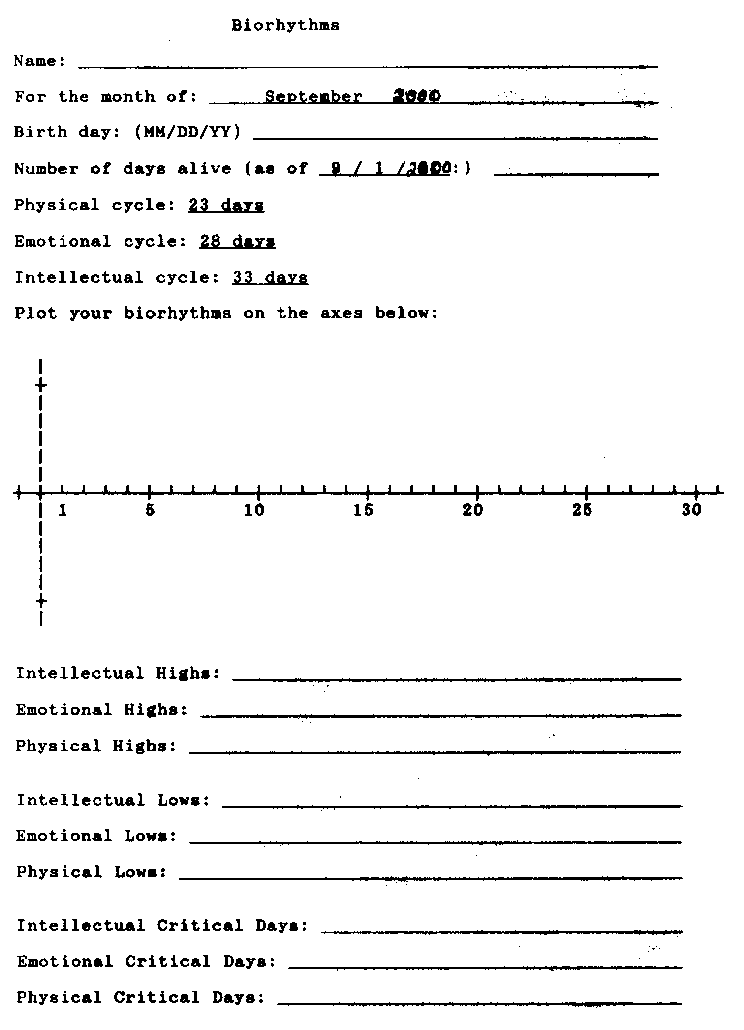In the 1970s, there was much interest in biorhythms, three cycles -- physical, emotional, and intellectual -- thought to affect our behavior .
Articles on biorhythm cite famous people -- Mark Spitz, Bobby Riggs, Billie Jean King, Marilyn Monroe -- and allude to biorhythmic forces at universally known momentous times in their lives.
Marilyn Monroe took a fatal dose of medication on a critical day; Sirhan Sirhan shot Bobby Kennedy on a critical day; and Jack Ruby, Arthur Bremer, and the Boston Strangler each became notorious on critical days. One author claims that people take risks on critical days that they would not take on other days. He says that the Canadian Royal Air Force surveyed a number of its soldiers' heroic actions. Eighty-eight percent occurred on critical days. He includes other statistics that indicate biorhythm is a significant predictor of good and bad performances.
The Theory of Biorhythms states that there are 3 "cycles"
to your life, which started on the day you were born:
The Physical Cycle: 23 days long
The Emotional Cycle: 28 days long
The Intellectual Cycle: 33 days long
Every twenty-three days the physical cycle (strength, energy, endurance, and resistance to disease) completes a full swing from neutral to high to neutral to low and back to neutral, resulting in a pattern that graphically resembles the sine function from 0° to 360°. The days between neutral and high, high and neutral, neutral and low, and low and neutral are not quantifiable except to say that they are above neutral or below neutral. Every twenty-eight days, you complete an emotional cycle that includes periods of elation, sadness, moodiness, and creativity. On high, peak days you are most likely to be elated and creative, and on low days you are the opposite. The intellectual rhythm (alertness, memory, and reasoning ability) completes a full cycle every thirty-three days. For aesthetic reasons, we draw the biorhythm curves similar to sine curves.
At the high points in each cycle you are at your peak physically, emotionally, or intellectually. These are the days when athletic records are set, you are feeling on top of the world, or you seem particularly erudite. These peaks occur approximately once a month for each cycle. The low points are not considered your bad days -- days when you should stay in bed -- but rather days when your mind and body are at rest. It is the neutral times, called "critical days," when you should be careful lest bad things befall you. The critical days are those when the curve crosses the axis of your graph. Beware!
Now that you are ready to find out if you should enter into business arrangements, try to go for a record in the mile, or warn your students that you are not to be crossed today, we shall show how to calculate your biorhythm.
On the day of your birth all three cycles began at the same time. To find out where you are in your three biorhythm cycles, consider the following example. Suppose you were born on 7 December 1944, and it is now 1 October 1977. You must first figure the number of days you have lived from your birth date to your last birthday -- 7 December 1976. Multiply 365 by your age, 32 in this -- example 365 X 32 = 11680. You must add an extra day for each leap year ('48, '52, '56, '60, '64, '68, '72, '76). There are eight in this example. Since it is now 1 October 1977, we must add the number of days since your last birthday, in this case 298. Thus, the number of days you have been alive is 11680 + 8 + 298 = 11986.
For those of you having trouble with "30 days hath
September..." here's a chart of the number of days
per month:
Jan -- 31
Feb -- 28
Mar -- 31
Apr -- 30
May -- 31
Jun -- 30
Jul -- 31
Aug -- 31
Sep -- 30
Oct -- 31
Nov -- 30
Dec -- 31
To compute where you are in your
twenty-three-day physical cycle,
divide the total
number of days lived by 23.
11986 / 23 = 521 r3
As of 1 October 1977, you have gone through 521 physical cycles plus three days. Thus, your physical cycle began again on 29 September.
On a piece of graph paper draw a vertical and a horizontal axis (fig. 1). You might wish to have a long horizontal axis to allow you to follow your cycle for a longer time period. Place the vertical axis at the left margin. The amplitude of your curve is unimportant, but it should be the same for all three cycles.
The emotional cycle is calculated in
much the same way.
11986 / 28 = 428 r2
Thus, the emotional cycle began on 30 September
(see figure 2).
The intellectual cycle is thirty-three days,
and to graph this cycle, we perform the
following:
11986 / 33 = 363 r7
This intellectual cycle began on 25 September (see figure 3).
A composite graph of figures 1, 2, and 3
is seen in figure 4. With all three curves on
the same axes, you can see double and
triple critical days. From this particular example,
we can see that toward the middle of
the month there is a quick succession of
critical days. And on 28 October there is a
double critical day. Beware!


Now complete the following sheet to determine you own biorhythms!

I have written a computer program in TRUE BASIC that allows you to enter a birthday and a day to be checked. It then computes your biorhythms and graphs them for you. It also finds the names of famous people who were born on your birthday. This program would be invaluable to teachers who assign each student to graph their biorhythms!
Click here for my downloadable program on biorhythms